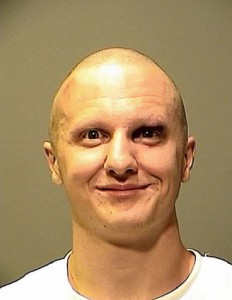 I’m reporting in Tucson this week about the Gabrielle Giffords shootings for my former (and occasionally current) employers. As usual on a reporting trip, my mind tends to fill not just with the particular story or angle I’m tasked with, but with all the other ephemera and strangeness of the event. I’ve been thinking a lot about Tucson architecture over the past day (my great-uncle is an architect here who designed a fair bit of modernist mid-century Tucson). I also can’t shake a half-thought about what a strangely intimate thing we’re reporting on with the Congresswoman—the flight of the bullet through her brain, which side was impacted, what the hospital is doing with her skull fragments. It’s so odd to remember that this vibrant politician, now this symbol of martyrdom, is just flesh and water, and that the national media is now keeping solemn vigil over that flesh as much as over the politician it comprised.
I’m reporting in Tucson this week about the Gabrielle Giffords shootings for my former (and occasionally current) employers. As usual on a reporting trip, my mind tends to fill not just with the particular story or angle I’m tasked with, but with all the other ephemera and strangeness of the event. I’ve been thinking a lot about Tucson architecture over the past day (my great-uncle is an architect here who designed a fair bit of modernist mid-century Tucson). I also can’t shake a half-thought about what a strangely intimate thing we’re reporting on with the Congresswoman—the flight of the bullet through her brain, which side was impacted, what the hospital is doing with her skull fragments. It’s so odd to remember that this vibrant politician, now this symbol of martyrdom, is just flesh and water, and that the national media is now keeping solemn vigil over that flesh as much as over the politician it comprised.
I’ve also been thinking a lot about Loughner’s parents. Four years ago, I was likewise thinking a lot about Seung-Hui Cho’s parents when I was at Virginia Tech after the shootings there. But they gave the world nothing in return for what their son had taken. They simply disappeared back to Korea (or, in my fantasies, to North Korea, where there’s a special camp just for the absconded parents of mass murderers). But Loughner’s parents are still here. From the swarm of reporters hunting down neighbors, we’ve learned that the Loughners were loners, and seemed aggressive to their neighbors. From a Time colleague who’s with me here in Tucson, I’ve learned that the Loughner house is a grim little box in a past-its-prime neighborhood. But this morning the Wall Street Journal has new detail from an interview with a neighbor, Wayne Smith, about the parents and their reaction to the crime:
Mr. Smith, who is 70 and has lived in a house across the street since 1972, said he didn’t know the couple’s last name until after Saturday’s rampage. And Mr. Loughner didn’t know his, he said. Still, he said he was probably one of Randy Loughner’s closest acquaintances in the neighborhood.
He said he believes Randy hasn’t worked since Jared was born. Amy had a steady job and Randy raised Jared, he said.
Residents interviewed on the block said they barely knew the Loughners. Stephen Woods, who lives next door, had run-ins with Mr. Loughner over uncollected trash that he said were vituperative and hostile.
Once, Mr. Woods said, Mr. Loughner spotted him from a distance in a Wal-Mart parking lot and repeatedly shouted “Trash people!”
It was Mr. Smith who told the Loughners what had happened Saturday. They returned from shopping, grocery bags in their peeling white Chevy truck, to find sheriffs’ cars parked in front of the house and deputies stringing up crime-scene tape.
Mr. Smith, who had seen the news on TV, walked up and told them their son was suspected in a mass shooting.
“She almost passed out right there,” Mr. Smith said. “He sat in the road with the tape up and cried.”
The part that caught my eye, as a part of this community of DadWagon, was that Jared Lee Loughner, the smirking shooter who killed a 9-year-old girl, was raised by a stay-at-home dad.
Which means, of course, nothing. Though I’ve been chastised this week (in the UK, no less!) for making an “amateur diagnosis” of Loughner’s mental health, I’ll say it again: dude was crazy. That’s not his parents’ fault. Though clearly there was some reporting, outreach, intervention that was lacking on their part. But even that has nothing to do with the fact that his father didn’t work and his mother did.
But it’s still worth thinking about: the Stay-at-Home-Dad has always been around, but it’s really only now that it’s rising in numbers and in the national consciousness. It now even has its own little downer of an acronym, SAHD. You’re going to start seeing lots more of SAHDs in sitcoms and novels and movies and everywhere else that new societal archetypes make their debut. The addition of the Loughner men to the SAHD resume should be looked at, I suppose, as a maturation of the genre. We who raise our children or are outearned by our wives or in general exist on the involved-dad-to-SAHD spectrum are trying to raise good people, engineers and poets and the like. But sometimes we raise killers, and that, too is life.
